There I was in Target, picking up some mundane supplies, when a display on an aisle end cap caught my eye: four-bottle packs of Pepsi Natural. Having ventured out from under my rock every once in a while, I was familiar with regular Pepsi, Diet Pepsi, Pepsi Max, and even Crystal Pepsi, but Pepsi Natural was new to my eyes. Curiosity was running through me like so much caffeine. What was this Pepsi Natural? How would it compare to the standard, plebeian product?
In one swift move, I snapped up a four-pack, swung around, and snagged a bottle of regular off of the nearby shelf. It was time for a new Pepsi Challenge, Pepsi on Pepsi.

The first thing I noticed, other than the fact that the “natural” variant was housed in glass bottles while the regular was in plastic, was the price difference. Including the CRV, the traditional Pepsi 2-liter rang up at $1.89, while the four 12 fl oz bottles of Pepsi Natural set me back $4.69. Scale that, and you’ll find that regular runs $3.69 per gallon, while super-ultra-premium-natural goes for an astonishing $12.50 per gallon. $12.50 per gallon! For sugar water! Yes, yes, I realize that bottles might affect the price, but should the glass privilege be worth that much? I mean, that price is in the bottled-beer neighborhood. Perhaps the contents would justify the difference.
Pepsi Natural is billed as being “all natural” and made with “sparkling water, sugar, and kola nut extract.” Indeed, the ingredient list has all that and more. Compared to the normal Pepsi, we find a different sweetener, a different type of fizzy water, an additional color source, different acids, and the addition of the kola nut extract.
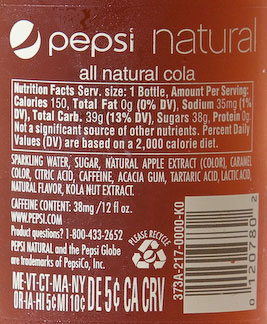
Pepsi Natural ingredient list
The most noticable difference is the exclusion of high-fructose corn syrup (HFCS) in favor of sugar alone. Some people have made a ruckus in recent years about the virtues of soft drinks sweetened with sugar instead of HFCS. Most major cola manufacturers made the switch to HFCS in the early 1980s, but some still have small production runs with the old-fashioned sweetener. Supposedly, Mexican Coca-Cola is sweetened that way, as is some Coke imported for Jewish customers. Supposedly, the taste is different (better), and possible health effects from HFCS are avoided (never mind the phosphoric acid). Would the difference be noticable here? Perhaps not, as regular Pepsi includes both regular sugar and HFCS.
One must also be aware that “natural” doesn’t mean “direct from a plant” or even “organic”; rather, for natural flavors, the chemicals were derived from something that was alive at some point rather than a source like petroleum or coal tar, which are “artificial.” Either way, you can bet that they went through a lot of processing and refinement before they met the bottle. Most of the minor ingredients in Pepsi Natural seem to have fairly straightforward routes from plants to bottles, but “natural flavors” remains unappealingly ambiguous.
Enough of that. Time for the taste test.
I let both the regular and natural Pepsi colas chill in the refrigerator overnight. The next day, I brought them out and poured a glass of each. Temperature at consumption: 57° F.
The first difference I noticed was the color. Both were brown, caramel-colored, and clear. However, the natural Pepsi was much lighter than the regular. Presumably, the difference was intentional, as they both contain coloring agents.

Pepsi colors: regular on the left, natural on the right
The next difference was the smell. While the regular cola had a sweet, somewhat acidic scent, the natural version had barely any smell at all. Perhaps that was related to the relative effervescence of the drinks: the regular appeared far fizzier, which might have released more aromatic compounds into the air.
Time for a sip. While the regular version had a biting, acidic feel, the natural felt smoother and more mellow. The regular mouthfeel was inferior, being somewhat astringent. There was a grittiness on my tounge and teeth with the regular version that seemed absent with the other. Overall, the taste profile was very similar. I think that the natural version had hints of cognac, but even in the non-blind test the two drinks were difficult to distinguish. Later, a couple of my friends also used the adjective “smoother” when describing Pepsi Natural versus regular Pepsi.
To take carbonation and the differing acids out of the picture, I added 1.2 g of sodium bicarbonate to 180 ml of each soda. The liquids fizzed madly, then went silent. I tried each of the now-flat drinks, and they tasted virtually identical: two cloyingly sweet, syrupy brown liquids. The underlying chemistry and provenance of the sweeteners are very different, but the tastes are pretty much the same.
Regardless of the form, the drinks contained what seemed to be an unhealthy amount of sugar. Pepsi Natural has slightly less sugar in a 12 fl oz serving, with 38 g versus 42 g for regular, but that’s still nearly a quarter of a cup by volume of crystallized sugar:
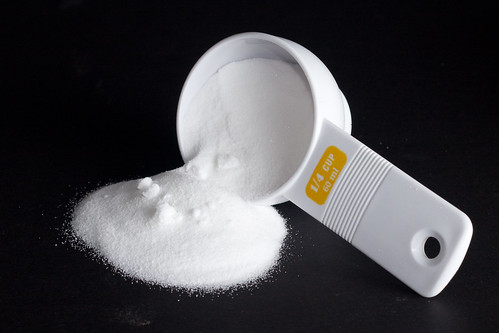
Amount of sugar in 12 fl oz of Pepsi (42 g)
Will Pepsi Natural find a permanent home in the market? Hard to say. History is littered with failed soft drink sub-brands. The price differential could be an issue, too: when money is tight, who is going to blow the budget by buying “natural” soda?
Frankly, I find all soft drinks to be far too sweet, and the fizziness is unappealing. I probably consume no more than a quart of soft drinks of any type in a given year. In fact, I could finish neither of the sample glasses, so most of the carmel-colored gold went down the drain.
In this Pepsi challenge, I’ll choose option (c): still water. Tastes better, much healthier, and a lot cheaper. And all natural, too.

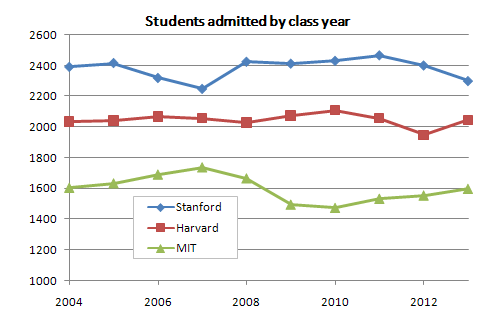
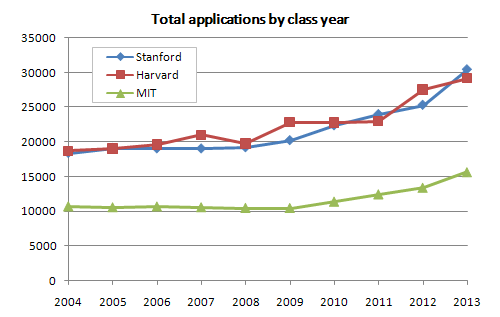
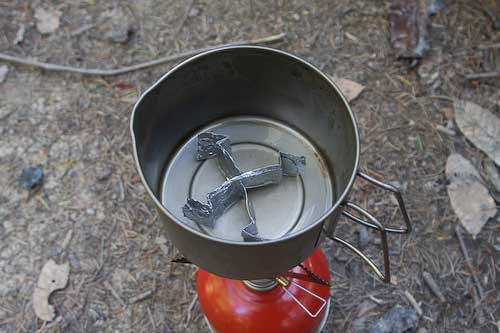
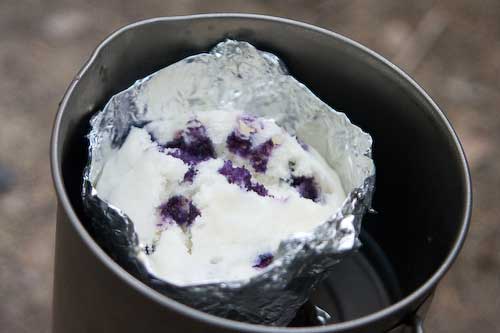
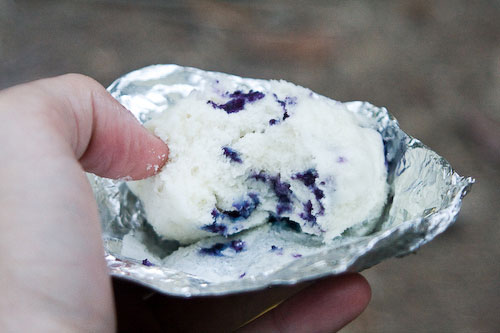




Recent Comments